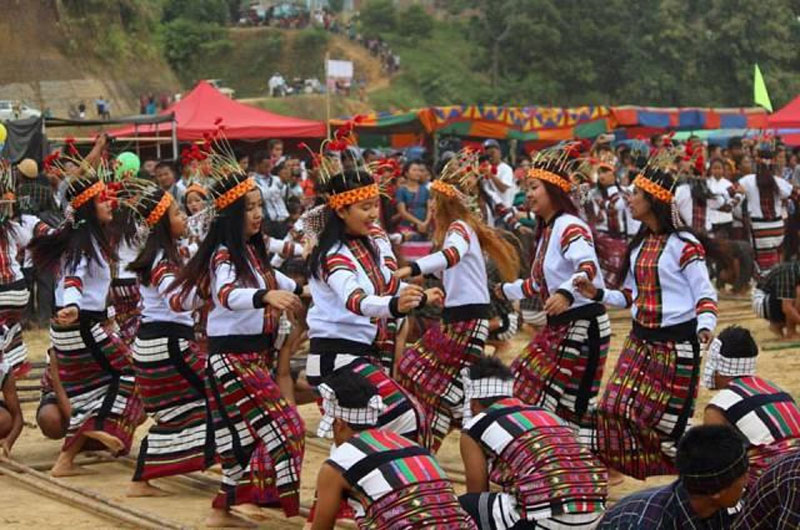
Festivals of Mizoram
Mizoram, nestled in the northeastern part of India, is a state rich in culture and tradition. The festivals of Mizoram are a vibrant display of the customs, beliefs, and lifestyle of its people. These celebrations bring communities together and showcase the state’s rich heritage. Here is a detailed exploration of some of the most significant festivals of Mizoram.
Chapchar Kut
Time of Festival
- March
Specialty of the Festival
- Significance: Celebrates the completion of the bamboo clearing process (jhum) for the new cultivation season.
- Activities: Traditional dances (Cheraw dance), music, sports, and feasting.
Locality of the Festival
- Celebrated by: Entire Mizo community
- Major Locations: Aizawl and other towns across Mizoram
Nature of the Festival
- Type: Agricultural and cultural
- Description: Chapchar Kut marks the end of the tedious bamboo clearing process in shifting cultivation. It is one of the most joyous festivals, featuring traditional dances like Cheraw (bamboo dance), where dancers rhythmically step in and out of bamboo poles. The festival includes music, sports, and communal feasting, symbolizing community spirit and cultural pride.
Mim Kut
Time of Festival
- August or September
Specialty of the Festival
- Significance: Celebrates the maize harvest and honors deceased relatives.
- Activities: Offering maize, bread, and meat to ancestors, traditional dances, music, and feasting.
Locality of the Festival
- Celebrated by: Entire Mizo community
- Major Locations: Rural areas of Mizoram
Nature of the Festival
- Type: Agricultural and religious
- Description: Mim Kut is a harvest festival dedicated to the maize crop. It involves rituals to honor ancestors by offering the first harvest of maize, bread, and meat. The festival is marked by traditional dances, music, and communal feasts, reflecting gratitude for the harvest and paying homage to deceased relatives.
Pawl Kut
Time of Festival
- December
Specialty of the Festival
- Significance: Thanksgiving festival celebrating the harvest.
- Activities: Traditional dances, singing, and community feasts.
Locality of the Festival
- Celebrated by: Entire Mizo community
- Major Locations: Throughout Mizoram
Nature of the Festival
- Type: Agricultural and cultural
- Description: Pawl Kut is a thanksgiving festival marking the end of the harvest season. It involves traditional dances, singing, and community feasts. Families gather to celebrate and express gratitude for the bountiful harvest. The festival is characterized by a spirit of joy and communal harmony.
Thalfavang Kut
Time of Festival
- November
Specialty of the Festival
- Significance: Celebrates the completion of weeding in the jhum fields.
- Activities: Traditional dances, music, and sports.
Locality of the Festival
- Celebrated by: Entire Mizo community
- Major Locations: Throughout Mizoram
Nature of the Festival
- Type: Agricultural and cultural
- Description: Thalfavang Kut marks the end of the weeding process in the jhum fields. The festival features traditional dances, music, and sports events. It is an occasion for the community to come together and celebrate the completion of an important agricultural task, reflecting the close connection between the Mizo people and their agricultural practices.
Christmas and New Year
Time of Festival
- December 25th and January 1st
Specialty of the Festival
- Significance: Celebrating the birth of Jesus Christ and the beginning of the new year.
- Activities: Church services, community feasts, singing, and dancing.
Locality of the Festival
- Celebrated by: Entire Christian community
- Major Locations: Throughout Mizoram
Nature of the Festival
- Type: Religious and cultural
- Description: Christmas and New Year are major celebrations in Mizoram, given the predominantly Christian population. The festivities include church services, carol singing, and community feasts. People decorate their homes, exchange gifts, and participate in traditional dances and music. The celebrations reflect the strong Christian faith and the communal harmony of the Mizo people.
Khawnglung Run
Time of Festival
- February
Specialty of the Festival
- Significance: Commemorates the historic battle of Khawnglung.
- Activities: Reenactments, traditional dances, music, and sports.
Locality of the Festival
- Celebrated by: Entire Mizo community
- Major Locations: Khawnglung village and other parts of Mizoram
Nature of the Festival
- Type: Historical and cultural
- Description: Khawnglung Run is a festival that commemorates the historic battle of Khawnglung. The festival includes reenactments of the battle, traditional dances, music, and sports events. It serves as a reminder of the bravery and resilience of the Mizo ancestors, fostering a sense of pride and cultural identity.
Mautam Festival
Time of Festival
- Cyclic (48-year cycle)
Specialty of the Festival
- Significance: Commemorates the flowering of bamboo and the subsequent rat infestation leading to famine.
- Activities: Traditional rituals, dances, and community solidarity events.
Locality of the Festival
- Celebrated by: Entire Mizo community
- Major Locations: Bamboo-rich areas of Mizoram
Nature of the Festival
- Type: Agricultural and cultural
- Description: Mautam is a unique festival that occurs in a 48-year cycle, coinciding with the bamboo flowering, which leads to a rat infestation and famine. The festival involves traditional rituals to mitigate the effects of the famine, dances, and community solidarity events. It highlights the resilience and unity of the Mizo community in the face of natural calamities.
The festivals of Mizoram are a vibrant expression of its cultural heritage and the close-knit nature of its communities. Each festival, with its unique significance and celebrations, offers a glimpse into the rich traditions and collective spirit of the Mizo people.
